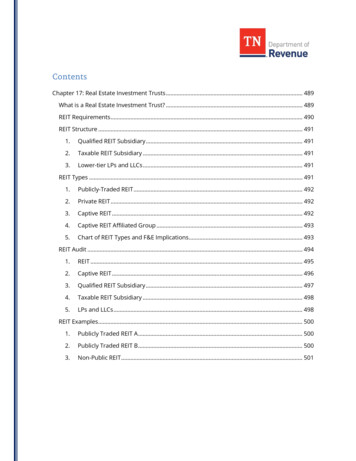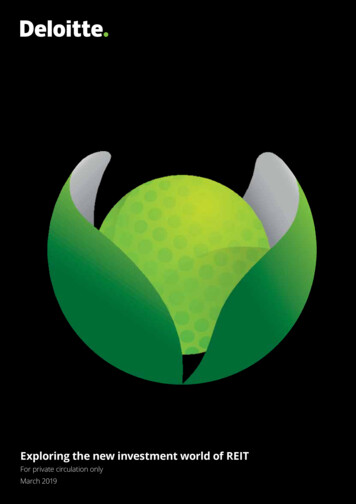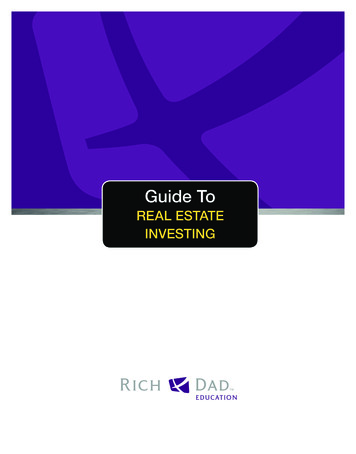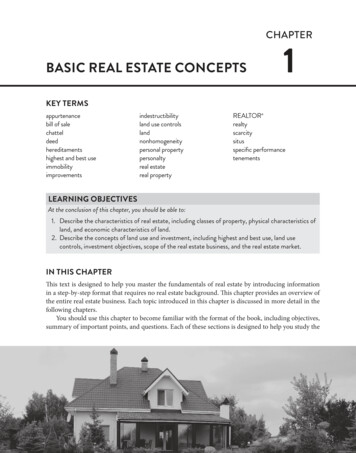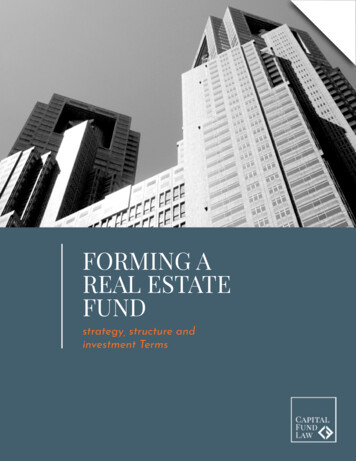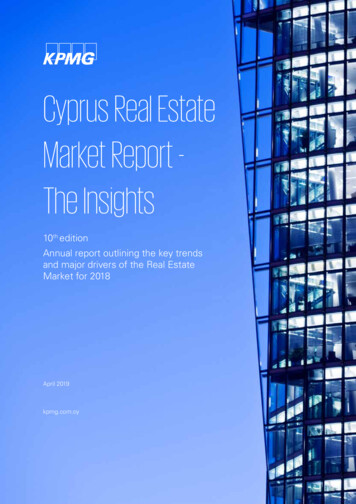
Transcription
POSITIVE IMPACT REALESTATE INVESTMENTFRAMEWORKA tool for holistic impact analysisPrinciples for Positive Impact FinanceImplementation GuidanceNovember 2018
POSITIVE IMPACT REAL ESTATEINVESTMENT FRAMEWORKUNEP FI Property Working Groupin collaboration with RICS, Global Investor Coalitionon Climate Change and PRINovember 2018Design and layout provided by Hermes Investment ManagementLEGAL DISCLAIMERS.This document has been prepared by UNEP FI. The views and opinions expressed herein are those of the authors anddo not necessarily reflect the official opinion of UNEP FI. Neither the United Nations Environment Programme (UNEnvironment), UNEP FI or any individual member or corporate may individually or collectively be held responsible forany use which may be made of the information contained herein. Mention of a commercial company or product in thisdocument does not imply endorsement by UN Environment or the authors. The use of information from this documentfor publicity or advertising is not permitted. Trademark names and symbols are used in an editorial fashion with nointention on infringement of trademark or copyright laws.
3 Positive Impact Real Estate Investment FrameworkCONTENTSIntroduction to UNEP FI and Collaborating Institutions. 4Executive summary. 61.Rationale for an Impact based real estate investment framework. 81.1.The Positive Impact Initiative. 91.2.Investor motivation for developing impact-based strategies.102.Impact-based Real Estate Investment Framework. 122.1.Clarity of Impact. 142.2.Market and Sustainable Returns. 172.3.Measurement of Impact. 192.4.Additional Finance and/or Impact Flows. 213.Applying the Impact-based Real Estate Investment Framework. 234.Challenges in developing impact-based real estate investment strategies.28Appendix A: Reference Resources.29ACKNOWLEDGEMENTSLead authors: Tatiana Bosteels, Director Responsibility & Head RPI, Hermes InvestmentManagement and Matthew Ulterino, Property Investment Project Coordinator,UNEP Finance Initiative.Special thanks to contributors and reviewers:Esther An, City Developments LimitedMaria Atkinson, Maria Atkinson ConsultancyArchie Beeching, PRIJake Goodman, PRIFelipe Gordillo, BNP ParibasRowan Griffin, LendleaseUrsula Hartenberger, RICSRyuichi Horie, CSR Design Green Investment Advisory, Co., Ltd.Masato Ito, Sumitomo Mitsui Trust Bank, LimitedZsolt Toth, RICSRachel Ward, IIGCCUNEP FI Secretariat – Positive Impact Initiative(Careen Abb, Elodie Feller, Jérôme Tagger, Sabina Timco)
4 Positive Impact Real Estate Investment FrameworkINTRODUCTIONTO UNEP FI ANDCOLLABORATING INSTITUTIONSUnited Nations Environment – Finance Initiative (UNEP FI) is a partnership betweenUnited Nations Environment and the global financial sector created in the wake ofthe 1992 Earth Summit with a mission to promote sustainable finance. More than230 financial institutions, including banks, insurers, and investors, work with UNEnvironment to understand today’s environmental, social and governance challenges,why they matter to finance, and how to actively participate in addressing them.UNEP FI members are signatories to a statement on sustainable development – acommitment to the integration of environmental and social considerations into allaspects of their operations.UNEP FI’s work also includes a strong focus on policy – by fomenting country-level dialoguesbetween finance practitioners, supervisors, regulators and policy-makers, and, at the internationallevel, by promoting financial sector involvement in processes such as the global climate negotiations.UNEP FI acts as a bridge between policy, regulation and practice to bring systemic change to thefinance sector and sustainable finance to scale.The UNEP FI Property Working Group (PWG) is a collection of more than 25 institutionalinvestors, asset managers, and commercial banks committed to enhancing property value by reducingthe sector’s energy and resource consumption and greenhouse gas emissions, addressing occupanthealth and wellbeing, and improving the physical and social environments where its assets lie. Itworks to: drive innovation in Responsible Property Investment (RPI) by facilitating access to relevantinformation and best practice and collaboratively develop the necessary tools to enable propertyinvestors and professionals to systematically apply and integrate ESG criteria into investmentand lending decisions; promote and encourage RPI by collecting and providing evidence to show how it can protector increase financial performance throughout the lifecycle of buildings while simultaneouslyreducing detrimental environmental and social impacts; and collaborate with policy-makers and the real estate investment community on developing andestablishing the appropriate policy and regulatory frameworks for RPI practices to grow.The Property Working Group is co-chaired by Tatiana Bosteels (Director – RPI & Sustainability,Hermes Investment Management) and Anna Murray (Vice President, Sustainability, Bentall Kennedy).On this – and many other projects – UNEP FI PWG works with a group of liked mindedinvestment organisations including the Royal Institution of Chartered Surveyors (RICS), thePrinciples for Responsible Investment (PRI), and the Global Investor Coalition on Climate Changemade up of Institutional Investors Group on Climate Change (IIGCC), Investor Group on ClimateChange (IGCC), Asia Investor Group on Climate Change (AIGCC), and Ceres Investor Networkon Climate Risk and Sustainability. It is through the collective knowledge and institutional reachbrought together through such partnerships that best practices and market shifts can accelerate.About the Asia Investor Group on Climate Change.The Asia Investor Group on Climate Change (AIGCC) is an initiative to create awareness amongAsia’s asset owners and financial institutions about the risks and opportunities associated withclimate change and low carbon investing. AIGCC provides capacity for investors to share bestpractice and to collaborate on investment activity, credit analysis, risk management, engagementand policy. AIGCC represents the Asian investor perspective in the evolving global discussions onclimate change and the transition to a greener economy. See www.aigcc.net and @AIGCC update
5 Positive Impact Real Estate Investment FrameworkAbout Ceres Investor Network on Climate Risk and Sustainability.The Ceres Investor Network on Climate Risk and Sustainability comprises more than 161 institutionalinvestors, collectively managing more than 25.2 trillion in assets, advancing leading investmentpractices, corporate engagement strategies and policy solutions to build an equitable, sustainableglobal economy and planet. The Network is a project of Ceres, a sustainability nonprofit organizationworking with the most influential investors and companies to build leadership and drive solutionsthroughout the economy. Through powerful networks and advocacy, Ceres tackles the world’sbiggest sustainability challenges, including climate change, water scarcity and pollution, and humanrights abuses. For more information, see orkAbout the Investor Group on Climate Change.The Investor Group on Climate Change (IGCC) is a collaboration of Australian and New Zealandinstitutional investors and advisors, managing over 2 trillion in assets under management andfocusing on the impact that climate change has on the financial value of investments. IGCC aims toencourage government policies and investment practices that address the risks and opportunities ofclimate change. www.igcc.org.au @IGCC UpdateAbout the Institutional Investors Group on Climate Change.The Institutional Investors Group on Climate Change (IIGCC), is the pre-eminent European forumfor investor collaboration on climate action and the voice of investors taking action for a prosperous,low carbon future. It has 153 mainly mainstream investors across 12 countries with over 21 trillionassets under management (including nine of the top ten largest European pension funds or assetmanagers). IIGCC’s mission is to mobilise capital for the low carbon transition by working withbusiness, policy makers and investors to encourage public policies, investment practices and corporatebehaviours that will address the long-term risks and opportunities associated with climate change.Members consider it a fiduciary duty to ensure stranded asset risk or other losses from climate changeare minimised and that opportunities presented by the transition to a low carbon economy – such asrenewable energy, new technologies and energy efficiency – are maximised. For more information, seewww.iigcc.org and @iigccnewsAbout the Principles for Responsible Investment (PRI).The PRI works with its international network of institutional investor signatories to put the sixPrinciples for Responsible Investment into practice. Its goal is to understand the investmentimplications of environmental, social and governance issues and to support signatories in integratingthese issues into investment and stewardship decisions. The six Principles were developed by investorsand are supported by the UN. There are over 2,100 signatories from over 50 countries representing US 81.7 trillion of assets (as of April 2018). The six Principles are voluntary and aspirational, offering amenu of possible actions for incorporating ESG issues into investment practices. In implementing thePrinciples, signatories contribute to developing a more sustainable global financial system. For moreinformation, see www.unpri.orgAbout the Royal Institution of Chartered Surveyors (RICS).RICS promotes and enforces the highest professional qualifications and standards in the valuation,development and management of land, real estate, construction and infrastructure. The RICS namepromises the consistent delivery of standards – bringing confidence to markets and effecting positivechange in the built and natural environments. For more information, see www.rics.org
6 Positive Impact Real Estate Investment FrameworkThe Positive Impact Initiative is promoting the idea that new lines ofbusiness and impact business models need to be developed and financed tomeet the SDGs. The Initiative seeks to move the financial sector towards amore thorough and deeper integration of impact analysis in decision-making.Institutions can thus step up their positive impact on the economy, societyand the environment, and actively participate in bridging the financing gap forsustainable development. Positive Impact seeks to deepen the practice of ESGintegration, in particular so that measurable environmental, economic andsocietal impacts – both positive and negative – are identified and measuredex-ante and ex-post independently of financial materiality (though the twomight overlap).To help property investors develop and implement an impact-based approach in theirinvestments, an action-oriented investor framework has been developed to help guidedecisions at any stage of the property investment cycle. The four Investment Objectivesoffer a way for institutions to frame decision-making for more immediate-term investmentactivities and longer-term aspirations that derive from Positive Impact’s holistic and impactbased approach.FIGURE: POSITIVE IMPACT REAL ESTATE FRAMEWORK INVESTMENT OBJECTIVESCLARITYOF IMPACTMARKET ANDSUSTAINABLE RETURNSIdentifying and creating impactfrom investment activityNo trade-off in financial resultswhile generating economic, social,environmental benefitsIMPACTADDITIONAL FINANCEAND/OR IMPACT FLOWSTo underserved products andmarkets; supporting physical andsocial factors that contribute tolong-term economic performanceMEASUREMENTOF IMPACTPositive and negative attributes andmitigating the negative; linking ex-anteand ex-post intent with impactSource: AuthorsFor each of the four Investment Objectives, the Framework provides a number of ‘leadingquestions’ and recommended actions to be considered by investment practitioners. Theycan support investors in the definition and development of their specific impact-based realestate investment approach. It is a guidance tool for institutions to move through a processof identifying impact ‘areas of influence’, identifying and executing investment opportunities,measuring ex-ante and ex-post impact, and re-orienting institutional capacities and capital.
7 Positive Impact Real Estate Investment FrameworkTABLE: POSITIVE IMPACT FRAMEWORK GUIDANCEGuidance for real estate investors on developing a positive impact-based investment strategyInvestors should use the following as framing questions and recommendations to support the development of theirimpact-based approach.CLARITY OF IMPACT: Does my impact-based approach clearly determineand describe my intended impacts and outcomes?Investors should:1. Use the UNEP FI PI Impact Radar to map, based onmateriality assessment, the relevant impact categoriesthey intend to address either through their existinginvestment activities and/or to identify potential newinvestment in underserved markets. This processenables investors to identify systematically thenegative and positive impacts across the three pillarsof sustainable development. Formal settlements Resource efficiency Wellness and well-beingThe investment themes should include anunderstanding of who will experience the outputsand whether they are underserved in relation to theoutcome.2. Define investment themes to address the relevantimpact categories (including mitigation actions, wherenegative), either by focusing on activities specific totheir real estate investment sector or by developingnew products for underserved markets. These couldinclude, for example:3. Identify relevant metrics and indicators and setappropriate targets defining the expected outputsfor each investment theme/impact category withina clearly identified timeframe. (See measurementsection below) Energy efficiency and clean energyLabour conditions and skills developmentSocial / affordable housingUrban regeneration (place making, communitydevelopment, safety and equity)4. For the sake of completeness and ease ofcommunication, further frame identified impactsand outcomes within macro objectives such as theSustainable Development Goals (SDGs) or the NewUrban Agenda. Ideally, they should identify relevantSDG targets which are specifically aligned with theimpact category.MARKET AND SUSTAINABLE RETURNS: Does my investment approach meet marketnorms and fiduciary standards while tangibly contributing to sustainable development?Investors should:Investors could:1. Analyse and collect evidence, whether quantitative orqualitative, that their impact-based approach deliversfinancial risk adjusted as well as sustainability returns.4. Consider some investment return discount toenable a wider coverage and potentially additionalgeographical markets and / or delivery pathways suchas a public private partnership to cover for risks andfirst losses if targeting underserved markets.2. Describe how their impact-based approach add valueto their investment strategy, such as in market demandor reputation.3. Analyse and describe the risks associated to thedelivery of their impact-based approach and howthat might affect meeting financial and sustainabilityexpectations (i.e., outputs and outcomes)5. Develop internal impact-based management protocols,which might include, for example determination ofremuneration metrics for impacts achieved, propertymanagement contracts tied to impact performance, etc.
8 Positive Impact Real Estate Investment FrameworkMEASUREMENT OF IMPACT: Do I have clear and transparent methodology(ies)to measure ex-ante and ex-post the expected outputs, and intended outcomes?Investors should:Investors could:1. Review existing methodologies and tools that cansupport the measurement of the relevant positiveand negative economic, societal and environmentalbenefits to identify those most relevant for theselected investment theme(s). (See Annex A forinformation on selected supporting resources.)4. Define the extent of supply chain coverage based oncontrol and seek to apply leverage and influence, forexample implement owner and tenant protocols fordata collection and increase in reporting frequency.2. Identify appropriate and available metrics andindicators related to the selected impact categories.Metrics and indicators can be both quantitative andqualitative or narrative based and should be developeddepending on data availability, completeness andquality and with a view to ensuring comparabilitybetween measurements.5. Introduce third-party verification of operational andquantitative metrics across all positive and negativeimpacts.6. Identify the methodological challenges that needfurther attention, and assign relevant resources toaddress these in time.3. Set clear ex-ante intentional targets, and measureex-post the actual outputs (and outcomes) achievedand mitigated in any of the three spheres ofsustainable development. Consider settingscience-based targets.ADDITIONAL FINANCE AND/OR IMPACT FLOWS: Has this approach enabled my institutionto go beyond a ‘business as usual’ or ‘best practice as usual’ trajectory – has it yielded impact andfinance flows which otherwise would not have been delivered? Does it cover underserved markets?Investors should:1. Assess if the impact-based approach is ‘additional’in finance (markets) and in impact (thematic) thatstakeholders can objectively measure, either relative toinstitutions or absolute to the sector? For example, in scale (a greater quantity to presently servedmarkets); new markets (serving undercapitalised sectors/sub-sectors); timing (an acceleration of the impact/financeflow);KEYQuestions institutional investors,asset owners, direct investmentmanagers and REITs should askthemselves. quality (a difference in capital cost or variety ofimpact); and persistence (how long the additional finance orimpact endures).2. Assess whether he impact-based approach specificallyaddress underserved / undercapitalised impactthemes, geographical markets, and/or property types/sub-sectors?Questions investmentmanagers and REITsshould ask themselves.Questions institutionalinvestors should ask oftheir investment managersand REITs.
9 Positive Impact Real Estate Investment Framework1. R ATI O N A L E F O R A N I M PAC T B A S E D R E A LE S TATE I N V E S TM E NT F R A M E WO R K1.1. THE POSITIVE IMPACT INITIATIVEThe Positive Impact Initiative brings together banks, investors, corporations andgovernments to co-create commercially viable, impact-based solutions to theSustainable Development Goals (SDGs). According to the United Nations, 5-7trillion are needed each year to meet the SDGs worldwide by 2030, to address needsin infrastructure, access to energy, water and healthcare. In low and middle-incomecountries particularly, the greater part of the necessary financing will need to comefrom private finance. The Initiative is promoting the idea that new lines of businessand impact business models need to be developed and financed to meet the SDGs. Bydoing so, businesses and finance institutions can step up their positive impact on theeconomy, society and the environment, and thus actively participate in bridging thefinancing gap for sustainable development.The Positive Impact Principles require a holistic approach: appraisal of both positiveand negative impacts, consideration of all three dimensions, i.e., economy, societyand environment, and transparency and assessment of methodologies and impactachieved as a core requirement.PRINCIPLE ONE: DefinitionPositive Impact Finance is that whwich serves to finance Positive Impact Business.It is that which serves to deliver a positive contribution to one or more of the threepillars of sustainable development (economic, environmental and social), onceany potential negative impacts to any of the pillars have been duly identified andmitigated. By virtue of this holistic appraisal of sustainability issues, Positive ImpactFinance constitutes a direct response to the challenge of financing the SustainableDevelopment Goals (SDGs).1.DefinitionPRINCIPLE TWO: FrameworksTo promote the delivery of Positive Impact Finance, entities (financial ornon-financial) need adequate processes, methodologies, and tools, to identify andmonitor the positive impact of the activities, projects, programmes, and/or entitiesto be financed or invested in.2.FrameworksPRINCIPLE THREE: TransparencyEntities (financial or non-financial) providing Positive Impact Finance shouldprovide transparency and disclosure on: The activities, projects, programs, and/or entities financed considered PositiveImpact, the intended positive impacts thereof (as per Principle 1); The processes they have in place to determine eligibility, and to monitor and toverify impacts (as per Principle 2); The impacts achieved by the activities, projects, programs, and/or entitiesfinanced (as per Principle 4).PRINCIPLE FOUR: AssessmentThe assessment of Positive Impact Finance delivered by entities (financial ornon-financial), should be based on the actual impacts achieved.3.Transparency4.Assessment
10 Positive Impact Real Estate Investment FrameworkThe Positive Impact Principles are intended for use by all segments of the finance sector.Positive Impact does not replace other existing principles or available frameworks (e.g., theEquator Principles, the Principles for Responsible Investment, Green Bond Principles, etc.).These or others focus on specific issue areas (e.g. climate change) or on specific segments ofthe market (e.g. project finance), and some can be considered building blocks for impact-basedapproaches and Positive Impact finance.Positive Impact can also respond to market appetite for labelled products and investments thatgenerate financial and positive outcomes to society, the environment and the economy. Thegrowth in the Green Bonds market is instructive, where capital pools wishing to profit fromthe low-carbon transition are matched with finance instruments that can propel that transition,supported by standards from which third-party opinions and assurances can be issued1. WhileUNEP FI does not seek to create nor manage a specific Positive Impact label, applying thePositive Impact Principles may similarly accelerate the creation of financial instruments orproducts which are holistic across multiple sustainability considerations.Alongside this investor resource specific to real estate, concurrent activities from the UNEP FImembership are focused on frameworks for other asset classes. More information on PositiveImpact Initiative activities can be found on the UNEP FI website.1.2. INVESTOR MOTIVATION FOR DEVELOPINGIMPACT-BASED STRATEGIESIt is increasingly well established in finance markets worldwide that failing to consider long-terminvestment value drivers and risks including environmental, social and governance (ESG) issuesin investment decision making processes is a failure of fiduciary duty2. ESG integration – thatis, the systematic and explicit inclusion of ESG factors into investment analysis and investmentdecision – can be captured in a number of ways.An impact-based approach seeks to deepen the practice of ESG integration, in particular sothat measurable environmental, economic and societal impacts – both positive and negative –are identified and measured ex-ante and ex-post independently of financial materiality (thoughthe two might overlap). It places holistic returns, i.e. both providing environmental andsocial outcomes while securing market level risk adjusted returns, as co-equal considerationsin investment selection and management. In addition, it seeks to contribute to investmentsolutions in underserved markets where governments and public institutions are increasinglylooking to private sources for finance and deliver measurable real outcomes to the economyand society.Positive Impact applies to all investment activities within institutions, though in practice thisprocess is presently in its early stages. Institutions will be subject to learning curves in buildingskills and capacity internally for an impact-based approach and for improved alignment betweenasset owners, asset managers, and others within the investment value chain. Analogously, for theindustry as whole, as illustrated in Figure 1.1 (see below), early adopters and close followers willoffer proof of concept and then generate momentum and acceptance from the mainstream3.1 See the Climate Bonds Initiative for more information: www.climatebonds.net/2 Fiduciary Duty in the 21st Century, www.fiduciaryduty21.org3 The UK National Advisory Board on Impact Investing in its report “The rise of impact: Five steps towards an inclusive and sustainableeconomy” (October 2017) lists five stages the industry follows before reaching a tipping point: Innovators; Visionaries; Pragmatists;Conservatives; and Laggards. It suggests the industry is moving into the Pragmatist stages, with an early majority operating in theimpact investment sector and where market scale and institutional credibility take root.
11 Positive Impact Real Estate Investment FrameworkPositive impact adoption(size of market)FIGURE 1.1: POSITIVE IMPACT ADOPTION CURVE: INVESTMENT SECTOR(MARKET SIZE AND TIMEFRAMES ARE INDICATIVE ONLY) Apply Impact analyses to ever largerportions of portfolio Push for cross-sector engagement,rationalisation in methods & metrics Scaling innovation Benefit from industry norms,convergence of asset ownersand investors expectations Follow rather than shapeindustry practices Impact-oriented capital Proprietary methods & metrics High innovationAdoption timeframe (full ESG & Positive Impact integration)Source: Authors (informed by The UK National Advisory Board on Impact Investing)Moving up the impact-based approach adoption curve is both a change in mindset frominvestors and a process of developing skills and capacity. The framework presented on thefollowing pages is to help guide investors with actions to facilitate such a change. Developingand utilising such frameworks, and seeding the market through Positive Impact products andinvestments that initially are a sub-set of an investors’ overall portfolio, allows for ‘learning by doing’and supportive resources to emerge (e.g., positive and negative assessment methodologies, externalverification providers, etc.).DEVELOPING AN IMPACT-BASED INVESTMENT STRATEGY FOR REAL ESTATEActions investors can take as they orient themselves on the adoption curve for applying an impact-based approach.1.Clarify the rationale for their ambition to andinterest in applying an impact-based approach.Typical rationale could include:a. Comply with evolving Fiduciary duty definitionsby considering long term impact of investmentactivities and ESG integration in decision makingb. G enerate additional value by capturing newgrowth opportunitiesc. R espond to market appetite for labelled productsand investments that generate financial andpositive outcomes to society, the environment,and the economyd. Contribute to investment solutions inunderserved marketse. S hift ‘best practice’ toward explicit planetary andsocietal thresholds2. Start by identifying the key challenges they willneed to be managed within their institutions anddevelop specific action plans to address there.These could range from:a. Capacity of internal resourcesb. A ccess to proprietary or sector-acceptedmethodologiesc. I nvestor and investee relations (building thebusiness case)3. Asset Owners and Investment Managers cansupport and operationalise their impact-basedapproach by the following steps:a. Communicate and signal their preference forPositive Impact products and instrumentsb. E ngage with investee companies on PositiveImpact business models and strategyc. S creen portfolios and allocate capital towardsPositive Impact companies and activitiesd. Develop new mandates and products targetingnew or under-supplied capital marketse. E ngage with public entities and policy makersto help scale up Positive Impact finance andbusiness models
12 Positive Impact Real Estate Investment Framework2 . I M PAC T- B A S E D R E A L E S TATEI N V E S TM E NT F R A M E WO R KTo operationalise the Positive Impact Principles, an action-oriented framework basedon four Investment Objectives has been developed. These objectives can help guidedecisions at each stage of the property investment cycle. They build on existing ESGintegration processes but go further in their reach. The objectives offer a way forinstitution
their real estate investment sector or by developing new products for underserved markets. These could include, for example: Energy efficiency and clean energy Labour conditions and skills development Social / affordable housing Urban regeneration (place making, com
